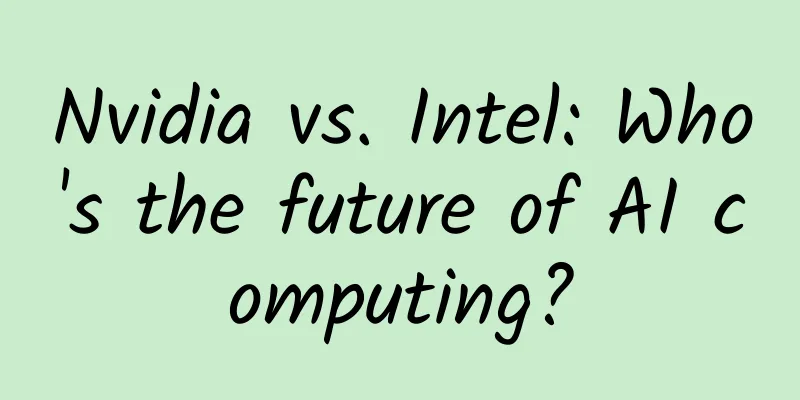Nvidia vs. Intel: Who's the future of AI computing?

|
Nvidia and Intel have been arguing over who will be the "brain" of the future . Nvidia believes that GPU (graphics processing unit) is far ahead in the field of artificial intelligence deep learning and will expand its advantage, while Intel believes that its CPU (central processing unit) will be able to replace the GPU to accelerate computing. On September 13, GTC CHINA 2016 (GPU Technology Conference) was held in Beijing. NVIDIA launched two new deep learning and autonomous driving products worldwide and announced a strategic partnership with JD.com to build a joint laboratory. At the Baidu World Conference held last week, NVIDIA co-founder, president and CEO Huang Renxun announced that NVIDIA and Baidu would cooperate in the field of autonomous driving. Due to its early layout, NVIDIA has a major advantage in the deep learning market. Currently, the vast majority of deep learning companies and institutions at home and abroad rely on NVIDIA's GPU acceleration. Global Internet giants including Facebook , Google, Alibaba , Baidu, etc. have cooperative relationships with NVIDIA. Google AlphaGo, which was unrivaled last year , was also connected to 170 GPUs. "Currently, the standard configuration for neural network calculations is GPU. Intel's investment in this area is insufficient and the CPU runs too slowly." A relevant person in charge of Turing Robotics, a leading domestic artificial intelligence developer, told Interface News reporters. In an interview with Interface News, Hu Rui, senior R&D director of the artificial intelligence group at Microsoft (Asia) Internet Engineering Academy, believes that GPUs have become a mainstream component of artificial intelligence computing architecture because GPUs used in graphics and image processing can process large amounts of data in parallel, which is very suitable for high-parallelism and high-localization data scenarios for deep learning. In the field of artificial intelligence, most companies currently use a "CPU+GPU" collaborative computing combination. In this heterogeneous mode, the serial part of the application runs on the CPU, while the GPU, as a coprocessor, is mainly responsible for the most arduous part of the computing task. Due to the strong demand for GPUs in deep learning, Nvidia's data center division's performance increased by 109% year-on-year. According to Nvidia's latest financial report released in August, its total revenue was US$1.428 billion, a year-on-year increase of 24%, and its profit reached US$253 million, a year-on-year increase of 873%. At the same time, the number of developers using Nvidia increased by 3 times to 400,000, and the number of artificial intelligence developers using Nvidia GPUs increased by 25 times. "NVIDIA is an artificial intelligence computing company," Huang Renxun said at the Baidu conference. Nvidia's sudden rise in the field of artificial intelligence computing has threatened Intel, a processor giant in the process of transformation. Without fully grasping the situation, Intel has adopted a strategy of recruiting and deploying extensively. In May this year, Intel announced the acquisition of computer vision software company Itseez; in June, Intel acquired FPGA manufacturer Altera for US$16.7 billion to strengthen its dedicated chip manufacturing capabilities; on August 9, Intel announced the acquisition of deep learning startup Nervana Systems; on September 7, Intel acquired machine vision startup Movidius, continuing to strengthen its deep learning solutions from device to cloud. Among them, Nervana was founded in 2014 by the former head of Qualcomm's neural network research and development. It has the fastest deep learning framework at present and is expected to launch a dedicated deep learning chip next year, which is said to be 10 times faster than GPU. After accumulating a certain amount of energy, Intel couldn't wait to launch a fierce counterattack against Nvidia, and a war of words between the two sides was about to break out. At the Intel Information Technology Summit (IDF 2016) held in August, Intel launched the new Xeon Phi series Knights Mil, and stated in a test report that the computing power of the new Intel Xeon Phi processor is higher than that of the GPU processors currently on the market, and the training speed is 2.3 times faster than that of GPU - pointing the finger directly at Nvidia. At the same time, Intel said it will launch a dedicated chip for artificial intelligence in 2017. The chip will introduce the function of accelerating artificial intelligence computing tasks for application in fields such as speech recognition, image recognition and autonomous driving. Subsequently, Nvidia strongly rebutted Intel's claim that "GPU is not as good as CPU". Ian Buck, vice president of Nvidia's accelerated computing business, published a blog post titled "Let's Talk About Intel's Mistakes on Deep Learning Benchmark", pointing out that Intel used data from 18 months ago for the comparison. If the updated Caffe AlexNet data is used, it will be found that four Maxwell GPUs are 30% faster than four Xeon Phi processors. "Intel should get the facts straight first," Ian Buck said without giving in. Regarding Intel's various layouts in the field of artificial intelligence, Huang Renxun expressed doubts on behalf of Nvidia: If the Xeon Phi coprocessor is very suitable for AI, then why did they acquire Altera? Since they bought Altera and Altera is very suitable for AI, why did they buy Nervada Systems? If Nervada Systems is the real AI technology and needs to be developed and launched, then what about the Xeon Phi coprocessor? If all three are suitable for AI, does that mean that the Xeon Phi coprocessor is not suitable for AI? "I don't quite understand their strategy at the moment, but our strategy is very beautiful and clear: that is GPU," said Huang Renxun. In response to Nvidia's questions, Rupal Shah, general manager of Intel China, said in an interview with Jiemian News and other media on September 6 that in fact Intel's strategy is not just focused on "deep learning", but rather on the entire artificial intelligence as an ecosystem. "Competition is a good thing for any industry. We hope to transform the benefits of the overall technological development of artificial intelligence into commercial results for consumers and achieve two-way flow from the cloud to the terminal," said Rupal Shah. Song Jiqiang, director of Intel China Research Institute, explained that Intel's layout in the field of artificial intelligence adopts a combination of software and hardware. The hardware uses a low-energy and high-efficiency method to implement calculations, while the software will optimize algorithms to reduce the amount of calculations. Such a response is obviously too broad and weak, but Sheng Linghai, a senior semiconductor industry analyst at Gartner, believes that since Intel itself is much larger than Nvidia and as a leader in the chip industry, "it has its own logic." "Intel is currently at a disadvantage in the artificial intelligence market. In order to provide corporate customers with more choices in the future and build a complete artificial intelligence ecosystem, Intel needs to have a wider coverage. Therefore, it must invest in the future and acquire new technologies that may appear or may be used." Sheng Linghai told Interface News reporters that as for whether it can form a market advantage in the future, it depends on whether the acquired technologies can be integrated and developed. In fact, as the artificial intelligence market is still in its early stages, processor manufacturers all hope to gain a foothold through their own products. Due to its focus on highly complex, neural network applications, Nvidia's GPU has not formed a monopoly position. In the heterogeneous mode, Nvidia has collaborative working relationships with Intel, IBM Power and ARM. "This stage of flourishing and vying for supremacy will last for 5-10 years, and it will take at least 3-5 years to see what kind of architecture will become a stable mainstream," Sheng Linghai predicted. Data shows that by 2025, the artificial intelligence market will reach a scale of 36 billion US dollars. Artificial intelligence will become the fastest growing part of the IT field and may lead the fourth industrial revolution after the steam engine, electricity, and computers. This is why Nvidia and Intel are competing fiercely for the AI market. However, the difference is that Intel wants to compete with Nvidia in a "tortoise and hare race" and firmly believes that it will overtake Nvidia; but Nvidia thinks that this latecomer does not play by the rules at all, and it is not sure whether the two are on the same track. Therefore, it seems that the war of words between the two sides will continue. As a winner of Toutiao's Qingyun Plan and Baijiahao's Bai+ Plan, the 2019 Baidu Digital Author of the Year, the Baijiahao's Most Popular Author in the Technology Field, the 2019 Sogou Technology and Culture Author, and the 2021 Baijiahao Quarterly Influential Creator, he has won many awards, including the 2013 Sohu Best Industry Media Person, the 2015 China New Media Entrepreneurship Competition Beijing Third Place, the 2015 Guangmang Experience Award, the 2015 China New Media Entrepreneurship Competition Finals Third Place, and the 2018 Baidu Dynamic Annual Powerful Celebrity. |
<<: What is it like to update an old iPhone to iOS 10? We did an experiment
Recommend
A complete guide to methods, cases and techniques for increasing followers on WeChat public accounts!
Today I would like to discuss with you how to inc...
You don’t know, these nine startups have been silently supporting your network behind the scenes
[[161777]] Granted, Amazon, Google, and Microsoft...
The stronger your blood vessels, the longer your life! Do these 8 things to slow down the aging of your blood vessels!
Ruan Lei, deputy chief physician of the Departmen...
Refined user growth case!
ABtest is gaining more and more attention. Fast a...
Can Cook's surprising move to resell iPhone 6 bring Apple back to life?
There has always been such a joke that in the sum...
What is open source? Where did it come from and where is it going?
Many domestic software companies or research inst...
In addition to PV and UV, product operations also need to pay attention to these indicators!
In the past six or seven years, I have been starti...
Toxic and carcinogenic, the harm is comparable to gutter oil! Many families still use it to cook
The Spring Festival is coming soon, and we will d...
The method of operating data activities is that simple!
E-commerce platform A has been established for ne...
Lei Jun, the car-making king, passed on a message that BYD, which makes mobile phones for Huawei, is the rightful heir to Xiaomi?
At this year's Xiaomi Spring New Product Laun...
China Automobile Dealers Association: Automobile consumption index in June 2022 is 80.7
On July 1 , 2022 , the China Automobile Dealers A...
Taking the 98 Shopping Festival as an example, how to use product thinking to promote sales
The Purchase Festival on September 8, 2016 was th...
Quickly establish business management strategic thinking_Zeng Qiao
Zeng Qiao——Teacher of Tsinghua CEO Class/Hejun CE...
Why do some trees grow fast and some slow?
Shi Jun Hello everyone, I am Shi Jun, a Ph.D. in ...
User operation: 4 steps to build a points system
Points can be found everywhere, such as membershi...
![[Artificial Intelligence] There is a "double agent" in life, do you know?](/upload/images/67f1e035242c7.webp)








